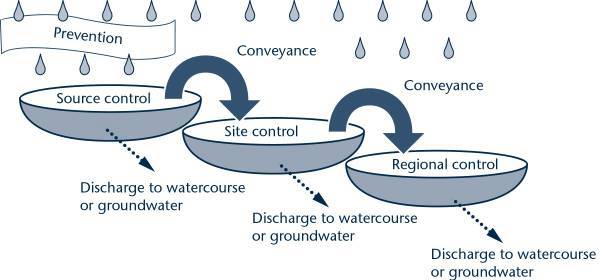What are Sustainable Drainage Systems
Sustainable drainage systems (SuDS) are a natural approach to managing drainage in and around properties and other developments.
SuDS work by slowing and holding back the water that runs off from a site, allowing natural processes to break down pollutants.
Types of SuDS
Source control measures deal with run-off at, or close to, the surface where rainfall lands.
Site control measures manage the surface water run-off from larger areas, such as part of a housing estate, major roads or business parks.
The run-off from larger areas can be channelled to a site control measure using swales (shallow drainage channels) or filter drains.
Regional control measures downstream of source and site controls deal with the gathered run-off from a large area. These systems use the same principles as smaller scale SuDS, but can cope with larger volumes of water.
Rainwater that passes through small SuDS can feed into larger SuDS which deal with the gathered run-off from a wide area. It is best to connect the flows between SuDS components with swales, filter drains or ditches and avoid the use of pipes.
SuDS treatment and attenuation
When you design a sustainable drainage system you should consider including a number of connected components. The more likely the runoff is to be contaminated the more stages of treatment should be included. This is known as the treatment train.
You can include source control measures to capture and treat runoff close to where it lands. You can connect a number of source controls to a site control measure such as a detention basin. The overflow from site control measures can be finally treated in a regional control SuDS measure before final discharge to the water environment.

Benefits of SuDS
The benefits of SuDS are:
- preventing water pollution
- slowing down surface water run-off and reducing the risk of flooding
- reducing the risk of sewer flooding during heavy rain
- recharging groundwater to help prevent drought
- providing valuable habitats for wildlife in urban areas
- creating green spaces for people in urban areas.
SuDS techniques
You can use the following SuDS techniques:
- green roofs - see the page in this guideline: green roofs in sustainable drainage systems (SuDS)
- permeable surfaces - see the page in this guideline: permeable paving in sustainable urban drainage systems (SuDS)
- infiltration trenches filter drains and filter strips - see the page in this guideline: filter strips and filter drains in sustainable urban drainage systems (SuDS)
- swales - shallow drainage channels - see the page in this guideline: swales in sustainable urban drainage systems (SuDS)
- detention basins, purpose built ponds and wetlands - see the page in this guideline: detention basins, ponds and wetlands in sustainable urban drainage systems (SuDS)
Further information
- SUSDRAIN: Videos on You Tube
- CIRIA: BeST (Benefits of SUDS Tool)
- CIRIA: SUSDRAIN
- SEPA: SuDS guidance
- Central Scotland Green Network: Raingardens for developers
